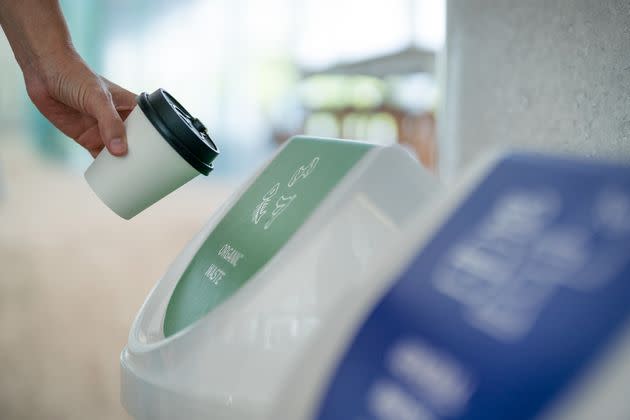You're Probably 'Wish-Cycling,' And It's A Huge Problem. Here's What To Do Instead.

Though our daily attempts to reduce our carbon footprint might feel futile at times, many of us are out here doing our best: reusing packaging, buying “vintage” clothing and even using those ridiculous paper straws that wither into our iced coffees within minutes.
One eco-conscious practice that’s been drilled into our psyches for decades is recycling. We’ve been taught that trash that isn’t recycled will inevitably end up crowding our already heaping landfills, creating harmful greenhouse gases and eventually reducing our Earth to a barren “Wall-E” hellscape.
While there’s a lot of truth to that, there’s also a very important caveat: If we aren’t recycling correctly, we could actually be doing more harm than good.
That’s right. Your noble efforts to go green might be backfiring.
“When in doubt, throw it out,” said Nena Shaw, director of the resource conservation and sustainability division at the Environmental Protection Agency told us, Raj Punjabi and Noah Michelson, on this week’s episode of HuffPost’s “Am I Doing It Wrong?” podcast.
Listen to the full episode by pressing play:
“There is so much ‘wish-cycling’ ― as in, we really want that children’s toy that is made of plastic to be recyclable. We really want it to be recyclable ― but it isn’t.”
Or we aren’t sure if that plastic yogurt container is recyclable, but we throw it in the recycling bin anyway.
But that’s bad news, because the materials that are collected from our homes are taken to recycling facilities where they are cleaned, sorted and packed in bales of similar items, which are then sold to manufacturers to be turned into new items. Companies want to purchase only “high-quality” bales, which means they contain little to no contaminants.
“You want everything in it to be what it’s supposed to be,” Shaw explained. “If it’s supposed to be cardboard or plastic or glass, you want it to be good and uniform. When you throw something in there that isn’t actually recyclable… they can reject the whole lot that has come in.”
Because of this, Shaw said, it’s actually better to throw an item we’re unsure about into the trash and let it end up in a landfill or incinerator rather than contaminate the recycling stream with it.
A simple way to become savvier about what can and can’t be recycled — and thereby avoid wish-cycling and contamination — is to learn your local recycling laws and guidelines. Every community has a different approach to recycling and takes different items, so becoming familiar with what and how to recycle in your area is your best tool.
Shaw also told us what those numbers on the bottom of plastic containers really mean, why composting is more critical than ever and much more.
Listen to the full episode above or wherever you get your podcasts.
Make sure to subscribe to “Am I Doing It Wrong?” so you don’t miss a single episode, including our investigations of the ins and outs of tipping; how to apologize or vanquish your credit card debt; how to find love online or overcome anxiety; tips for online shopping, taking care of your teeth and pooping like a pro; secrets to booking and staying in a hotel; how to deal with an angry person; cooking tips from celebrity chef Jet Tila; shocking laundry secrets; tips and tricks for cleaner dishes; getting your best workout; the germiest spot in a restaurant; myths about wine; and more.
Need some help with something you’ve been doing wrong? Email us at AmIDoingItWrong@HuffPost.com, and we might investigate the topic in an upcoming episode.

